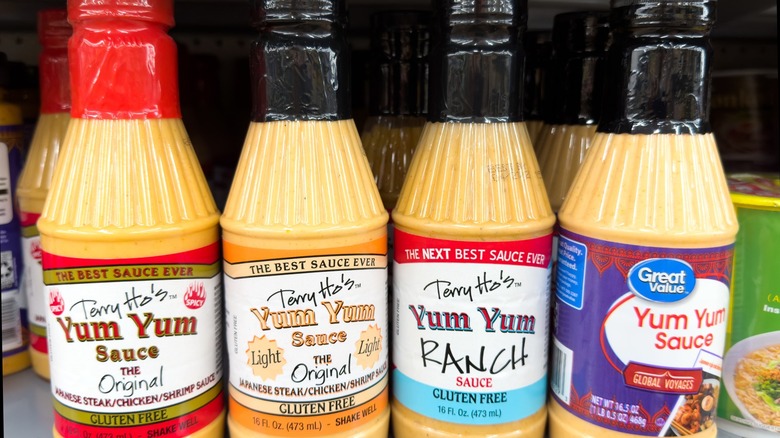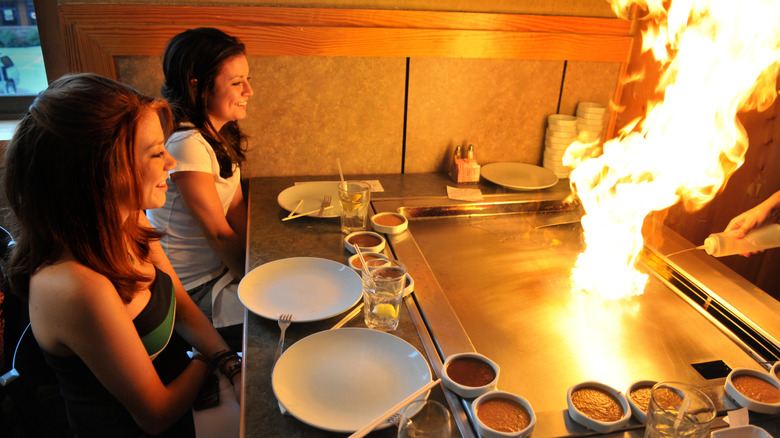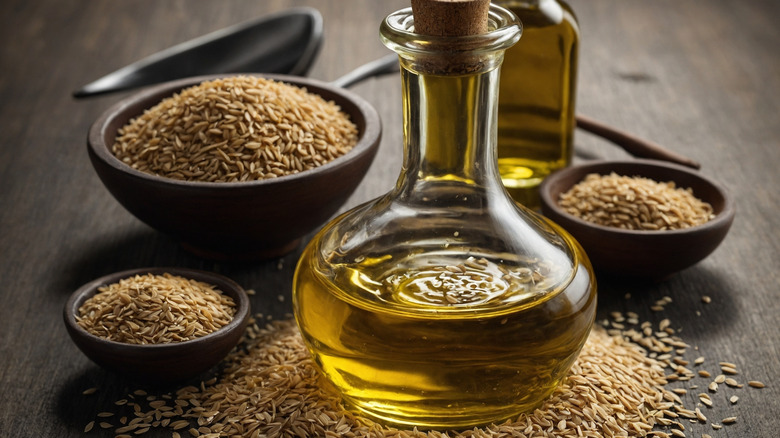The American Origins Of The Yum Yum Sauce We Love Today
If you've ever been to a Benihana, Japanese steakhouse, , or any other teppanyaki-style restaurant, there's no doubt that you've heard about the infamous yum yum sauce. It really needs no introduction because it's that good.
Despite the deliciously grilled shrimp, chicken, steak, and veggies, the fluffy white rice, or those perfect yakisoba noodles with the satisfying chewiness—you come for the sauce. Period. For years, and even still today, everyone was trying to figure out how in the world to make this exotic Japanese condiment that tastes good on everything.
Well, you may be surprised to know that the creamy, tangy, orange-pink sauce actually has American roots that likely evolved from a fusion of Japanese-American cuisine. Through multiple interviews with Japanese culinary experts, we've since discovered that yum yum sauce isn't a staple of Japanese cooking.
In Asian restaurants, it quickly became a fan-favorite that accompanied what felt like every patron's plate. While recipes vary, most versions blend mayonnaise, tomato paste, sugar, and spices. Here's a glimpse at the history of Yum Yum sauce and an easy recipe that you can add to your arsenal.
Where it all began and where we are now
Some people also call it white sauce, shrimp sauce, Sakura sauce, or pink sauce. It may depend on where you're located, but you generally know what's being referenced. It first became popular in Japanese hibachi steakhouses across America, where chefs started using it as a versatile dipping sauce for everything from grilled meats to seafood and vegetables.
Considering the fact that yum yum sauce is most commonly associated with Japanese restaurants, most people think of it as a Japanese delicacy. Instead, it's a relatively simple creation that was started (no one knows exactly when) in Japanese establishments, probably aiming to cater to American taste buds. Over time, chefs added their own twist to create the perfect balance of tangy and sweet.
Yum yum sauce might have stayed a secret of hibachi grills if it weren't for Terry Ho, who took it from restaurant tables to grocery store shelves with this distinctive name. Ho, a chef and entrepreneur, started bottling his own version of the sauce in 2012 after realizing how popular it had become among customers. What started as a small operation has now grown into a full-scale business, with Terry Ho's Yum Yum Sauce available in stores nationwide.
Make your own delicious Yum Yum sauce (you need this secret ingredient)
There are a zillion copycat recipes out there that cater to cracking the code on how to get that coveted yum yum that tastes just like its from Benihana. I've tried this one, and it's as close as I've ever gotten to the authentic version from the restaurants. It's also easy, most ingredients aren't hard to find in stores, and I keep figuring out ways to tweak it and make it better.
First, the secret ingredient I'm referring to is sesame oil. It adds a crucial flavor element that a lot of yum yum hacks seem to miss. You can experiment with non-roasted or roasted, for varying levels of smokiness. Traditionally, there's a mayo base, and that's fine, you can substitute the recipe below for 1 cup of mayo instead of the almond or chickpea flour that I and other yum yum connoisseurs enjoy using.
To make yum sauce, start with ½ cup of almond flour (or chickpea flour) and ⅓ cup of nutritional yeast for a creamy texture. Combine ½ cup of canola oil with ⅓ cup of sesame oil for richness. For the base, use ½ cup of chickpeas or replace them with ⅓ block of silken tofu. Add ½ cup of fresh lemon juice, ½ teaspoon of salt, and 1½ teaspoons of curry powder. Finally, mix in a clump of fresh cilantro, water for consistency, and spices like dried oregano and sage.
This is a good recipe to have on hand, because let's be real, that bottle from the grocery store only lasts a week, anyway!


